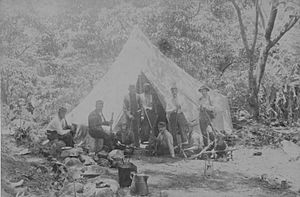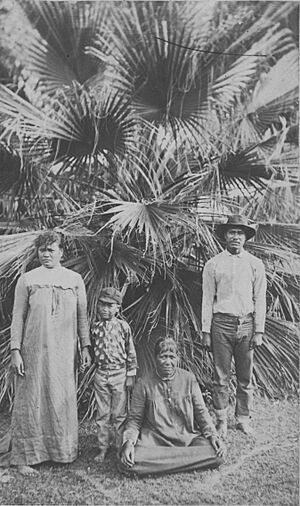Leper War on Kauaʻi facts for kids
Quick facts for kids Leper War on Kauaʻi |
|||||||
|---|---|---|---|---|---|---|---|
| Part of Hawaiian Revolutions | |||||||
 Soldiers of the National Guard Auxiliary of the Provisional Government of Hawaii camped in Kalalau Valley. |
|||||||
|
|||||||
| Belligerents | |||||||
| Kalaupapa Leprosy Settlement | |||||||
| Commanders and leaders | |||||||
| Kaluaikoolau |
Sanford B. Dole |
||||||
| Casualties and losses | |||||||
| 27 captured | 3 killed | ||||||
The Leper War on Kauaʻi, also known as the Koolau Rebellion, was a short conflict in July 1893. It happened on the island of Kauaʻi in Hawaii. This war began after the Hawaiian Kingdom was overthrown. The new government wanted to strictly enforce a law about leprosy, a serious skin disease. This law meant that anyone with leprosy had to move to a special colony. This colony was located in Kalaupapa on the island of Molokai. Many people with leprosy did not want to leave their homes. This led to a revolt in the Kalalau Valley on Kauaʻi.
Contents
Why the Conflict Started
The Leper War began when a deputy sheriff named Louis H. Stoltz tried to move people with leprosy from Kalalau Valley. These people lived in an isolated community. On June 27, 1893, a man named Kaluaikoolau, also known as "Ko'olau," shot and killed Sheriff Stoltz. Ko'olau had leprosy himself.
The new government in Hawaii wanted to control leprosy to protect the economy. They believed that separating people with the disease would stop its spread. Their plan was to send everyone with leprosy to the colony on Molokai.
On June 24, 1893, Deputy Sheriff Stoltz and two other policemen went to Kalalau. They wanted to enforce the quarantine law. They spent a day planning their actions. The next day, Stoltz's group went deeper into the valley. They set up a camp. Soon, a group of people with leprosy, led by Ko'olau, took over the camp. They chased the lawmen back to the coast.
The next day, Ko'olau wanted to make sure the sheriffs left the valley. Ko'olau and his wife, Piilani, found Stoltz trying to arrest another man. Ko'olau fired his weapon, and Stoltz was killed.
The Kalalau Expedition
The killing of Sheriff Stoltz angered the new government. President Sanford B. Dole saw it as a challenge to their authority. Marshal Edward G. Hitchcock quickly sent a military group called the Kalalau Expedition. Captain William Larsen led this group. It included 35 soldiers from the National Guard of Hawaii. They also brought a small cannon called a howitzer. A health official, Charles B. Reynolds, was also with them.
The soldiers traveled to Kalalau by ship. On June 30, they stopped in Hanalei to gather information. They learned that police were guarding the paths to Kalalau. They also heard that a special law was announced. This law said that all people with leprosy had 24 hours to surrender. After that, they would be captured, dead or alive.
Ko'olau had a group of 12 people with him, armed with rifles and pistols. This group included his son Kaleimanu and his wife Piilani. At the last minute, Ko'olau decided to leave his group. He thought the soldiers would search harder for him. But Piilani refused to leave her husband. Kaleimanu also stayed with his parents.
Landing in Kalalau
The ship arrived at Kalalau on July 1. Fifteen soldiers landed first. They found no problems, only local people. The rest of the expedition then landed and set up camp about a mile inland. Soldiers guarded the stream. They searched the area and captured a leader named Reverend Kapahei "Judge" Kauai. Three other people with leprosy were also captured from a cave.
On July 2, a local man named Wahinealoha, who was helping the government, was asked to convince the people with leprosy to surrender. The expedition moved another mile inland and set up a main camp called "Camp Dole." Captain Larsen fired the howitzer five times. He hoped the loud noise would scare the people hiding in the valley.
Later that day, Wahinealoha returned. He said a group of people with leprosy were ready to surrender if Luther Wilcox met with them. Wilcox and others met with them. After being promised good treatment, eight people from Ko'olau's group came out and surrendered. The next day, soldiers searched for Ko'olau. They even tried to use his sister to lure him out. But the valley was empty, and they could not find him.
First Attack on Ko'olau
On July 4, Sergeant Major J. W. Pratt's group of 15 soldiers found Ko'olau. He was with his wife Piilani and son Kaleimanu. They were hiding in caves on the side of a western ridge in the valley. Pratt sent a four-man team to attack the cave. The rest of his men provided cover fire.
As the team got close, Ko'olau shot the first soldier, Private John Anderson. Anderson was a Norwegian soldier. He fell and knocked two of his comrades down the mountain. Anderson later died from his wound. The other two soldiers survived their fall but were badly hurt. The group had to go back to Camp Dole.
That afternoon, the ship returned to Honolulu with 15 captured people with leprosy.
Second Attack
On July 5, Captain Larsen led a second attack with 15 men. One group fired at the cave for fifteen minutes. Then, an assault group, led by Reynolds, tried to enter the cave. The first soldier in this group was Private John McCabe. He had fought in the American Civil War. As McCabe tried to climb into the cave, Ko'olau killed him.
Again, the soldiers had to retreat. During their retreat, Private John Herschberg's rifle got caught in plants and accidentally fired, killing him. On July 6, Pratt used the howitzer to fire at the cave. The soldiers continued searching for others. But Ko'olau and his family had already left the cave during the night before the attack.
On July 7, Reynolds and six soldiers gathered ten more people with leprosy in Hanalei. These people had been caught outside Kalalau. They were sent to Honolulu by ship.
Third Attack and End of Campaign
William Owen Smith from the Board of Health felt that the war was embarrassing. He went to Kalalau himself on July 10. He brought ten new soldiers and supplies. Smith found that Captain Larsen had given up on finding Ko'olau. Larsen and his men had moved to the next valley to search for other people with leprosy.
After a long argument, Smith and Larsen returned to Ko'olau's cave. They found it empty. Patrols were sent to search the area, but they found nothing. Smith saw how thick the plants were in the valley. He decided that finding Ko'olau was impossible. So, he called off Larsen's mission.
What Happened Next
The soldiers left Kalalau. The campaign had captured 27 people. The remaining people with leprosy in Kalalau were not bothered again. The captured people were sent to the colony in Kalawao. The community of people with leprosy in Kalalau broke up. They began to live in separate homes.
Ko'olau and his family remained safe. They stayed hidden in the valley for many more years. Eventually, Ko'olau and his son died. Piilani, Ko'olau's wife, then left the valley. She later shared her story, which was published in a book.
In 1897, William Smith's brother, Jared K. Smith, was killed. People thought it was revenge by a relative of someone who had been threatened with deportation. A Hawaiian man named Kapea was arrested, tried, and executed for the murder.
In Popular Culture
The Leper War is often seen as a successful act of standing up against unfair treatment of people with leprosy and Hawaiians.
Piilani wrote about her experiences. Her book was published in 1906. It was called Ka Moolelo oiaio o Kaluaikoolau, which means The True Story of Kaluaikoolau in Hawaiian.
The events also inspired a long poem called The Folding Cliffs by W. S. Merwin.
Jack London wrote a short story about the incident called "Koolau the Leper."




